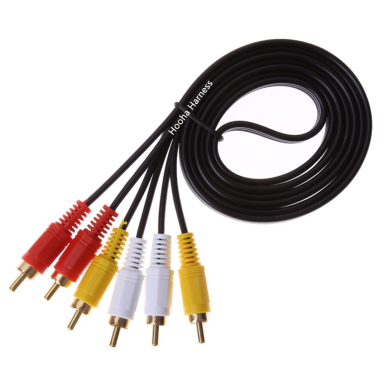As technology advances, a variety of audio and video connectors have emerged on the market, each with its own unique advantages and disadvantages. As a supplier, we not only provide high-quality RCA cables, but also provide customers with other connector options to help them find the best fit.


1. RCA cable vs. HDMI
HDMI (High-bandwidth Multimedia Interface) is one of the most commonly used audio and video transmission standards, supporting high-definition (HD) and even ultra-high-definition (UHD) video transmission and multi-channel audio.
Transmission signal type: RCA cables are mainly used for analog signal transmission, while HDMI is used for digital signal transmission. HDMI is capable of transmitting high-resolution signals for audio and video, and even supports resolutions of 4K and above. RCA cables can only transmit standard-definition analog signals, which is backward in modern HD equipment.
Audio support: RCA cables can only transmit stereo signals, requiring multiple cables to transmit left and right channel audio separately. HDMI can simultaneously transmit multi-channel audio signals, such as Dolby Atmos, to provide users with a more immersive audio experience.
Simplicity: RCA cables usually require three (or more) cables to transmit audio and video signals separately, while HDMI only needs one cable to transmit high-definition audio and video signals, so the connection and wiring are simpler.
Application scenarios: RCA cables are more suitable for older devices, such as old TVs, DVD players, and home audio systems. HDMI is the preferred connector for modern HD and UHD TVs, Blu-ray players, game consoles, and other devices.
2. RCA cable vs. optical audio cable
Optical audio cable (TOSLINK) transmits audio data via optical signals and is widely used in modern home entertainment systems and high-fidelity audio equipment.
Transmission signal type: RCA cables transmit analog audio signals, while optical cables transmit digital audio signals. Optical fiber cables can support higher quality audio, such as 5.1 and 7.1 channel surround sound, while RCA cables only support analog stereo.
Anti-interference: Optical fiber audio cables are not affected by electromagnetic interference because they use optical signals for transmission, and can ensure the purity of the signal. In contrast, although RCA cables are equipped with a shielding layer, they may still be affected by electromagnetic interference, especially when transmitted over long distances.
Application scenarios: RCA cables are suitable for standard audio connections and are often used in old audio equipment. Optical fiber audio cables are more suitable for modern home theater systems, high-definition audio equipment, and gaming equipment, especially in applications that require high-fidelity audio.
3. RCA cable vs. 3.5mm audio jack
The 3.5mm audio jack is a common audio interface on many of our devices, such as headphones, mobile phones, computers, etc.
Transmission signal type: Both RCA cables and 3.5mm jacks are used for analog audio transmission. However, 3.5mm jacks are usually used in portable devices, while RCA cables are more used in home audio equipment.
Flexibility: 3.5mm jacks are more portable and suitable for small devices such as headphones and speakers. RCA cables are suitable for devices that require a more secure connection, such as home theaters and audio systems.
Application scenarios: 3.5mm jacks are suitable for personal audio devices, while RCA cables are more suitable for connections that require higher audio quality in professional or home entertainment equipment.
4. RCA cable vs. XLR cable
XLR cable is a three-pin connector widely used in professional audio equipment, such as microphones and recording equipment.
Transmission signal type: XLR cable transmits balanced audio signals, which can provide higher quality audio, especially in long-distance transmission. RCA cable transmits unbalanced audio signals, which is suitable for short-distance audio connections.
Anti-interference: XLR cable is designed for long-distance audio transmission and has strong anti-interference ability, while RCA cable is more suitable for short-distance audio connections.
Application scenario: XLR cable is mainly used in professional audio equipment, such as recording studios and performance equipment. RCA cable is widely used in home audio systems and consumer audio equipment.
RCA cable still has a place in audio and video connections, especially in equipment that needs to transmit analog signals. It is known for its simplicity, reliability and cost-effectiveness, especially for old equipment and standard audio/video transmission. Although modern equipment is increasingly adopting digital connectors (such as HDMI and optical fiber), the wide compatibility and stable performance of RCA cable make it still indispensable in the field of home entertainment and professional audio.
As a professional supplier of RCA cables, we offer a variety of specifications and customization services to help customers find the best connection solution for their devices. Whether you need a standard RCA cable or a custom length, color or shielding design, we can meet your needs and ensure that the quality and performance of the product meet the highest standards.


